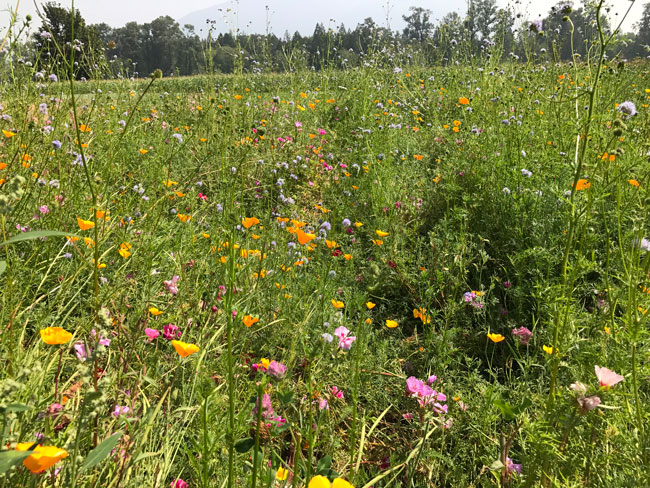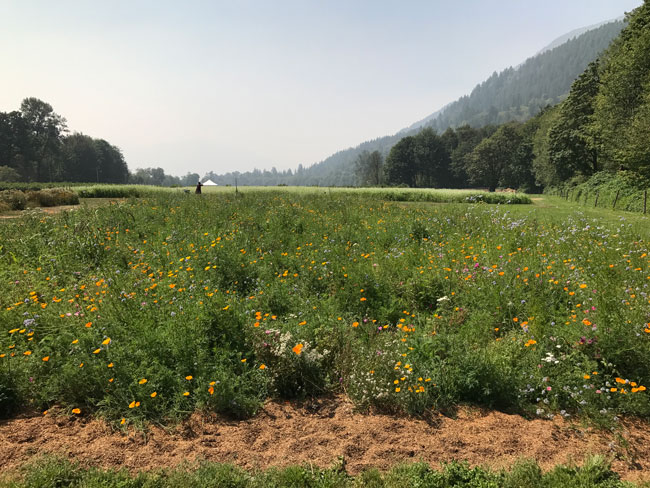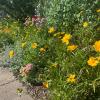Nestled in the foothills of the breathtaking North Cascades mountain range in western Washington’s Upper Skagit Valley, Cascadian Farm is now even more beautiful with the addition of a showy new meadow. Working with farm director Ashley Minnerath and farmer Clay Godbolt, Xerces designed the 1/4 acre meadow and site preparation process using only organic practices. The meadow is a welcome addition to the farm, attracting pollinators to the meadow and the adjacent blueberry crops. Also nearby is an ice cream stand – right in front of the meadow!
At their home farm, Cascadian Farm grows about a dozen acres of closely spaced blueberries and another dozen or so acres of mixed berries and vegetables. After having used honey bees many years ago to pollinate crops, Cascadian Farms took a big leap of faith and decided to rely entirely on native bees for pollination. Since moving in that direction, yields have not changed. In retrospect this was an easy move since the farm already had fantastic habitat, and is completely pesticide free. However, until the meadow was added, most of the existing on farm habitat consisted of spring-flowering shrubs in the forested areas immediately surrounding the farm. The goal of this meadow project was to increase the abundance of flowering plants, especially in summer and autumn (a list of species used in this meadow seed mix can be found at the end of this blog).

The process began with a farm plan and habitat assessment that Xerces conducted in late 2014. The farm is used frequently as a training center for food industry leaders with regular tours and working retreats held on site to provide education on organic farming, cover cropping, and now – pollinator conservation. When we formulated the initial conservation plan, we collectively decided to focus energy and time on the development of a big, showy wildflower meadow next to the blueberry crops in a highly visible space directly behind the visitor center and roadside stand. A mulched path around the meadow allows for easy access to view the bees and blossoms.
Because the farm is entirely organic, we wanted to avoid any use of herbicides in preparing the meadow area for planting and ultimately decided on solarization. Solarization involves covering an area of land with plastic for an entire growing season. Trapping the heat from the sun, this method is highly successful for killing annual and perennial weeds as well as much of their seedbank. I was initially concerned about proposing the strategy, thinking a quarter-acre piece of plastic in such a highly visible location might cause some objections. The response was quite the opposite. After installing the plastic, they immediately put up “Pollinator Habitat In Progress” signs around the site with an educational message about solarization.
While we had wanted to get the plastic on a little earlier in 2016, busy workloads and slow plastic delivery delayed things. Consulting with Ashley Minnerath, the farm director, she and I decided to leave the plastic down all winter because we were not completely confident of the amount of weed suppression achieved during summer.
When we were very confident that most of the weeds and dormant weed seeds were eliminated, we pulled off the plastic and sowed the wildflower seed. It should be noted that there are two common concerns that arise when people first hear about solarization.
First, there is typically a very justifiable concern about the plastic waste generated. We continue to explore recycling options for the solarization plastic we use in our projects. Unfortunately options for recycling agricultural plastics are generally poor. To compensate for this, we work to take very good care of solarization plastic enabling it to be used many times. In fact, we have some solarization sheets that are now several years old and get used on different farms year after year to expand even more areas of habitat. Cascadian Farm is no different, with the plastic used for this project being put to good use at another location on the farm.
Second, people are sometimes concerned about the impact of solarization on beneficial soil organisms. This concern is complicated. Currently some research suggests that weeds tend to have different of mutualistic soil organisms than native plants. Our trials tend to confirm this hypothesis based upon the excellent performance we observe in solarized soils versus restored habitat where the soil was not heat treated. We suspect that solarization’s ability to create a “blank slate” helps the native plants better re-establish their own mutualistic relationships with their preferred soil organisms.
So far, the results at Cascadian Farm are consistent with our results elsewhere and continue to look excellent!

Near the tail end of this project it got an especially great boost from the efforts of two newer members of the Xerces pollinator team. When Cameron Newell and Kitty Bolte joined Xerces in early 2017, the three of us made a trip to the site to do an evaluation. Cameron and Kitty brought fresh eyes and fresh perspectives when they conducted follow-up monitoring at the farm to help assess weed pressure and to review the final seeding specifications. Their involvement was really valuable since we knew that this would be one of the most visible projects we have worked on – being right next to the roadside farm stand, publicly accessible, and with a lot of roadside visibility–everything had to be perfect! And, it is. Reaching the end of its first growing season, the site has less than 5% weed cover and bountiful blooms. The public is welcome to visit, grab a scoop, and enjoy the meadow.
By Eric Lee-Mäder, Pollinator Program Co-Director
Cascadian Farm pollinator meadow seed mix
Douglas meadowfoam (Limnanthes douglasii)
large flower collomia (Collomia grandiflora)
shade phacelia (Phacelia nemoralis)
globe gilia (Gilia capitata)
farewell to spring (Clarkia amoena)
California poppy (Eschscholzia californica)
winecup clarkia (Clarkia purpurea)
diamond clarkia (Clarkia rhomboidea)
sea blush (Plectritis congesta)
springbank clover (Trifolium wormskioldii)
fireweed (Chamaenerion angustifolium)
Douglas aster (Symphyotrichum subspicatum)
selfheal (Prunella vulgaris)
western yarrow (Achillea millefolium)
large camas (Camassia leichtinii)
Puget Sound gumweed (Grindelia integrifolia)
Canada goldenrod (Solidago canadensis)
riverbank lupine (Lupinus rivularis)
rose checkermallow (Sidalcea virgata)
common camas (Camassia quamash)
bigleaf lupine (Lupinus polyphyllus)
meadow checkermallow (Sidalcea campestris)
showy milkweed (Asclepias speciosa)
prairie Junegrass (Koeleria macrantha)
blue wild rye (Elymus glaucus)
Roemer’s fescue (Festuca romerii)
California oatgrass (Danthonia californica)
California brome (Bromus carinatus)
tufted hairgrass (Deschampsia ceaspitosa)
meadow barley (Horedum brachyantherum)
slough sedge (Carex obnupta)



